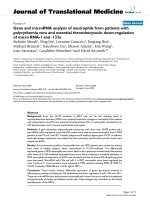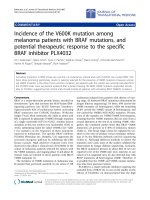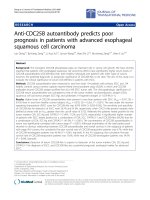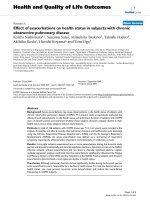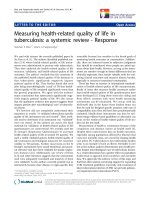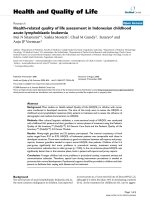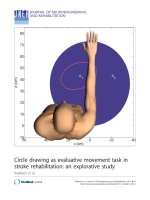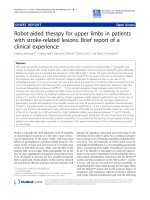báo cáo hóa học:" Th1 type lymphocyte reactivity to metals in patients with total hip arthroplasty" potx
Bạn đang xem bản rút gọn của tài liệu. Xem và tải ngay bản đầy đủ của tài liệu tại đây (511.08 KB, 11 trang )
BioMed Central
Page 1 of 11
(page number not for citation purposes)
Journal of Orthopaedic Surgery and
Research
Open Access
Research article
Th1 type lymphocyte reactivity to metals in patients with total hip
arthroplasty
Nadim James Hallab*
1
, Marco Caicedo
1
, Alison Finnegan
2
and
Joshua J Jacobs
1
Address:
1
Department of Orthopedic Surgery, Rush University Medical Center, Chicago, IL 60612, USA and
2
Department of Rheumatology, Rush
University Medical Center, Chicago, IL 60612, USA
Email: Nadim James Hallab* - ; Marco Caicedo - ;
Alison Finnegan - ; Joshua J Jacobs -
* Corresponding author
Abstract
Background: All prostheses with metallic components release metal debris that can potentially
activate the immune system. However, implant-related metal hyper-reactivity has not been well
characterized. In this study, we hypothesized that adaptive immunity reaction(s), particularly T-
helper type 1 (Th1) responses, will be dominant in any metal-reactivity responses of patients with
total joint replacements (TJAs). We tested this hypothesis by evaluating lymphocyte reactivity to
metal "ions" in subjects with and without total hip replacements, using proliferation assays and
cytokine analysis.
Methods: Lymphocytes from young healthy individuals without an implant or a history of metal
allergy (Group 1: n = 8) were used to assess lymphocyte responses to metal challenge agents. In
addition, individuals (Group 2: n = 15) with well functioning total hip arthroplasties (average Harris
Hip Score = 91, average time in-situ 158 months) were studied. Age matched controls with no
implants were also used for comparison (Group 3, n = 8, 4 male, 4 female average age 70, range
49–80). Group 1 subjects' lymphocyte proliferation response to Aluminum
+3
, Cobalt
+2
,
Chromium
+3
, Copper
+2
, Iron
+3
, Molybdenum
+5
, Manganeese
+2
, Nickel
+2
, Vanadium
+3
and Sodium
+2
chloride solutions at a variety of concentrations (0.0, 0.05, 0.1, 0.5, 1.0 and 10.0 mM) was studied
to establish toxicity thresholds. Mononuclear cells from Group 2 and 3 subjects were challenged
with 0.1 mM CrCl
3
, 0.1 mM NiCl
2
, 0.1 mM CoCl
2
and approx. 0.001 mM titanium and the reactions
measured with proliferation assays and cytokine analysis to determine T-cell subtype prominence.
Results: Primary lymphocytes from patients with well functioning total hip replacements
demonstrated a higher incidence and greater magnitude of reactivity to chromium than young
healthy controls (p < 0.03). Of the 15 metal ion-challenged subjects with well functioning total hip
arthroplasties, 7 demonstrated a proliferative response to Chromium, Nickel, Cobalt and/or
Titanium (as defined by a statistically significant >2 fold stimulation index response, p < 0.05) and
were designated as metal-reactive. Metals such as Cobalt, Copper, Manganese, and Vanadium were
toxic at concentrations as low as 0.5 mM while other metals, such as Aluminum, Chromium, Iron,
Molybdenum, and Nickel, became toxic at much higher concentrations (>10 mM). The differential
secretion of signature T-cell subsets' cytokines (Th1 and Th2 lymphocytes releasing IFN-gamma
Published: 13 February 2008
Journal of Orthopaedic Surgery and Research 2008, 3:6 doi:10.1186/1749-799X-3-6
Received: 13 July 2007
Accepted: 13 February 2008
This article is available from: />© 2008 Hallab et al; licensee BioMed Central Ltd.
This is an Open Access article distributed under the terms of the Creative Commons Attribution License ( />),
which permits unrestricted use, distribution, and reproduction in any medium, provided the original work is properly cited.
Journal of Orthopaedic Surgery and Research 2008, 3:6 />Page 2 of 11
(page number not for citation purposes)
and IL-4, respectively) between those total hip arthroplasty subjects which demonstrated metal-
reactivity and those that did not, indicated a Th1 type (IFN-gamma) pro-inflammatory response.
Conclusion: Elevated proliferation and production of IFN-gamma to metals in hip arthroplasty
subjects' lymphocytes indicates that a Th1 (vs. Th2) type response is likely associated with any
metal induced reactivity. The involvement of an elevated and specific lymphocyte response suggests
an adaptive (macrophage recruiting) immunity response to metallic implant debris rather than an
innate (nonspecific) immune response.
Background
Implant related metal hypersensitivity remains a relatively
unpredictable and poorly understood phenomenon. [1-3]
Dermal hypersensitivity to metal is common, affecting
about 10–15% of the population. [1,2,4,5] Dermal con-
tact and ingestion of metals have been reported to cause
immune reactions which most typically manifest as skin
hives, eczema, redness and itching. [1,5-7] Although little
is known about the short and long term pharmacodynam-
ics and bioavailability of circulating metal degradation
products in vivo,[4,8,9,9,10] there are many case and
group studies documenting metal reactivity responses
temporally associated with implantation of metal compo-
nents.
All metals in contact with biological systems cor-
rode[11,12] and the released metal ions, while not sensi-
tizers on their own, can act as haptens, activating the
immune system by forming complexes with native pro-
teins. [4,13,14] Metal-protein complexes are considered
to be candidate antigens for eliciting hypersensitivity
responses. Metals known as sensitizers (haptenic moieties
in antigens) are beryllium,[15] nickel,[5-7,15] cobalt[15]
and chromium[15] while occasional responses have been
reported to tantalum,[16] titanium [17,18] and vana-
dium. [16] Nickel is the most common metal sensitizer in
humans followed by cobalt and chromium. [1,4-7]
The specific T-cell subpopulations associated with metal
hypersensitivity, the cellular mechanism of recognition/
activation, and the antigenic metal-protein determinants
created by implant metals remain incompletely character-
ized. Th1 (T-helper type 1) and Th2 (T-helper type 2) cor-
respond to CD4+ αβ TCR T cell subsets that provide help
to cells of both the innate and adaptive immune systems.
We hypothesized that adaptive Th1 mediated responses
will be the more prevalent type of hypersensitivity
response to metal in patients with total hip arthroplasty
(THA). We investigated this hypothesis by evaluating the
reactivity of peripheral blood lymphocytes to metal chal-
lenge agents (Cobalt, Chromium, Nickel and Titanium)
in subjects with and without hip arthroplasties using pro-
liferation and cytokine assays. We studied lymphocyte
responses in three different subject groups: i) young
healthy individuals without implants and without a his-
tory of metal allergy were used to assess general lym-
phocyte reactivity to various concentrations of metal
challenge agents; ii) individuals with hip arthroplasty
were determined to be either metal-reactive or metal-non-
reactive by cell proliferation studies, and iii) age matched
controls without implants were used to assess lymphocyte
subtype dominance by cytokine release profiles.
Materials and methods
Contrasting the metal reactivity responses of healthy sub-
jects without implants and subjects with implants was
used to assess the immunogenic effects of metals found
retrospectively in orthopaedic implant cohorts (n = 31
total subjects). Informed consent was obtained from all
subjects after Institutional Review Board review and
approval. Group 1 consisted of young healthy subjects
without any metallic implants (n = 8, 4 male and 4 female
subjects with an average age of 29, range 23 to 36) and
was primarily used for determination of relative metal
toxicity and upper limits of challenge dose. In Group 1
subjects lymphocyte proliferation in response to a variety
of metals (Aluminum-Al
+3
, Cobalt-Co
+2
, Chromium-Cr
+3
,
Copper-Cu
+2
, Iron-Fe
+3
, Molybdenum-Mo
+5
, Manga-
neese-Mn
+2
, Nickel-Ni
+2
, Vanadium-V
+3
and Sodium-Na
+2
chloride solutions, Sigma, St Louis, MO) at a variety of
concentrations (0.0, 0.05, 0.1, 0.5, 1.0 and 10.0 mM) was
studied to establish toxicity thresholds. Group 2 consisted
of 15 hip arthroplasty single-implant type subjects with
well functioning (average Harris Hip Score = 91) total hip
arthroplasties of the same design (Harris-Galante, Zim-
mer, Warsaw, IN) with 7 males and 8 females (average age
69 yrs, range 55–80 yrs), and an average hip arthroplasty
time in-situ of 158 months (range 117–174 months). This
implant system is comprised of a Titanium-6%Alumi-
num-4%Vanadium alloy stem with a Cobalt-Chromium-
Molybdenum femoral head, an Ultrahigh Molecular
Weight Polyethylene (UHMWPE) acetabular cup in a Tita-
nium-6%Aluminum-4%Vanadium alloy lining. A sample
size of 14 in each group will have an 80% power to detect
a probability of 0.81 that an observation in one group is
less than an observation in the other group using a two-
sided Mann-Whitney test with a 0.05 significance level.
Two of 15 reported a history of metal allergy and 5 of 15
had moderate osteolysis (proximal focal lesions in excess
of 0.5 cm
2
in total area on an anteroposterior radiograph
Journal of Orthopaedic Surgery and Research 2008, 3:6 />Page 3 of 11
(page number not for citation purposes)
and/or distal [diaphyseal] focal lesions greater than 1 cm
2
in total area on an anteroposterior radiograph were corre-
lated with the magnitude of articular surface wear). [19]
Group 3 subjects were age-matched controls (to Group 2)
with no implants (Group 3, n = 8, 4 male, 4 female, aver-
age age 70, range 49 to 80). Group 2 subjects with hip
arthroplasty were evaluated for lymphocyte reactivity to
metals using lymphocyte transformation testing (prolifer-
ation assays), and IFN-gamma, IL-2, and IL-4 cytokine
analysis. The metal challenge agents for Group 2 subjects
were a subset of the more prevalent implant-alloy metals
used for appropriate dose determination in Group 1 and
consisted of 0.1 mM CrCl
3
, 0.1 mM NiCl
2
, 0.1 mM CoCl
2
(Sigma, St. Louis, MO) and approx. 0.001 mM titanium
(using Titanium saturated culture medium produced
through incubation with Titanium beads). Despite its
prominence as an implant alloy, titanium could only be
tested at such low concentrations because of the insoluble
nature of titanium at physiologic pH and its subsequent
inability to form ions in solution.
Proliferation assays
(Lymphocyte Transformation Tests): Serum and Periph-
eral Blood Mononuclear Cells (PBMCs) were obtained
from mononuclear cell fractionation of blood obtained
by peripheral venipuncture after obtaining informed con-
sent and Institutional Review Board approval. Peripheral
blood mononuclear cells were isolated from 30 mL of
peripheral blood using density gradient separation
(Ficoll-isopaque, Pharmacia, Piscataway, NJ). Ficoll sepa-
rated mononuclear cells are generally comprised of 85–
95% lymphocytes with 5–13% monocytes and <0.1%
dendritic cells with limited contamination (i.e. <5%
erythrocytes and <3 granulocytes). Among mixed periph-
eral blood mononuclear cells populations, lymphocytes
are the only cells capable of competitively significant in
vitro proliferation upon challenge with an allergen. Thus
we used standard Lymphocyte Transformation Testing
(LLT) protocol of mononuclear cells to measure lym-
phocyte proliferation and cytokine production (15–30 ×
10
6
cells per subject). [20,21] Lymphocytes in all assays
were incubated with Dulbeccos Modified Eagles Medium
and 10% autologous serum with either no metal (plain
media) as a negative control, 0.01 mg/ml phytohemagglu-
tinin (PHA) as a positive control, or metal. Each metal
challenge treatment was conducted in quadruplicate (4
wells/treatment). [
3
H]-thymidine was added (1 mCi/cul-
ture well) during the last 12 hours of incubation after 5 1/
2 days of treatment. At day six, [
3
H]-thymidine uptake was
measured using liquid scintillation. Incorporated radioac-
tivity was measured using liquid scintillation Beta plate
analysis (Wollac Gatesburg, MD). The amount of [3H]-
thymidine incorporation for each metal treatment was
normalized to that of the nontreated control producing a
ratio, referred to here as the proliferation index or stimu-
lation index, SI.
The SI was calculated using measured radiation counts per
minute (cpm):
Stimulation Index = (mean cpm with treatment)/(mean
cpm without treatment). (1)
Six days of incubation were used to reproduce, in vitro,
the time lag associated with in vivo lymphocyte prolifera-
tion in a delayed type hypersensitivity (DTH) response.
[20,21]
Measurement of cytokines in culture media
Cell surface markers have been proposed to differentiate
Th1 vs. Th2 subtypes (e.g. Th1 cells have been reported to
express both components of IL-12 receptor chains (b1 and
b2) while Th2 cells exhibit only IL-12Rb1). [22] However,
these methods remain technically problematic and not
well established for large scale multi-challenge agent and
human cohort characterization. Thus current investigative
methods of Th1/Th2 subtypes largely remain the differen-
tiation of signature cytokine expression, i.e. Th1 = Inter-
feron gamma (IFN-gamma), tumor necrosis factor beta
(TNF-b) and interleukin 2 (IL-2), and Th2 = Interleukins
4, 5, 6, and 13 (IL-4, 5, 6, and 13). [22-24] Cytokine con-
centrations in supernatants of lymphocytes cultures (>1 ×
10
6
PBMCs per well per metal in 48-well plates) were
obtained after 48 hrs of incubation with metal challenge
agents and were measured by sandwich enzyme-linked
immunosorbent assays (ELISA) in 96-well microtitration
plates following the manufacturer's instructions. ELISA
kits (R&D Systems, Minneapolis, MN) for IL-2, IL-4 and
IFN-gamma (assay range from 0.5 to 32 pg/ml) were con-
ducted in triplicate for each concentration of each metal
treatment.
Statistical analysis
Normally distributed data were subjected to statistical
analysis using Student's t-tests. Student's t-tests for inde-
pendent samples with unequal or equal variances were
used to test equality of the mean values at a 95% confi-
dence interval (p < 0.05). A sample size of 14 in each
group will have an 80% power to detect a probability of
0.81 that an observation in one group is less than an
observation in the other group using a two-sided Mann-
Whitney test with a 0.05 significance level. Comparisons
between groups were limited to comparison of reactivity
at each metal concentration. All treatment specific reactiv-
ity SI measurements were assumed to be normally distrib-
uted. The results from the cytokine assays were not
normally distributed as some measurements were below
the detection limit. By convention, to calculate group
means, cytokine concentrations below the detection limit
Journal of Orthopaedic Surgery and Research 2008, 3:6 />Page 4 of 11
(page number not for citation purposes)
were assigned a value of one-half the method detection
limit. Intergroup comparisons, independent of these
means, were made using Kruskall-Wallis non-parametric
analysis of variance. The Wilcoxon-Mann-Whitney test
was then used if the Kruskall-Wallis test revealed signifi-
cant differences at p < 0.05.
Results
Lymphocyte Proliferation
The concentration dependent effects of metals on healthy
individuals without implants (Group 1) demonstrate the
differential effects of implant metals on lymphocytes and,
more importantly, verify that the metal dose chosen for
Group 2 analysis was non-toxic, i.e. 0.1 mM (Figure 1).
Generally, there was a decrease in proliferation associated
with an increase in metal concentration for all the metals
tested. Only Nickel was found to induce a statistical
increase in proliferation at concentrations of 0.5 and 10
mM, respectively (p < 0.05, t-test). Almost all metals
induced toxic/inhibitory effects. The most to least inhibi-
tory metals were Manganeese
+2
, Copper
+2
, Vanadium
+3
,
Cobalt
+2
, Nickel
+2
, Molybdenum
+5
, Aluminum
+3
, Iron
+3
,
and Chromium
+3
based on the smallest metal concentra-
tions required to produce a decrease in proliferation of
over 50%. The only metals that did not demonstrate a tox-
icity response at concentrations as high as 10 mM were
Chromium and Sodium. Sodium was used as a control to
account for the effects of chloride. The most toxic of the
metals, Manganeese, Copper and Vanadium, decreased
proliferation to below 50% at concentrations below 0.1
mM, indicating that for these particular metals lower con-
centrations may be appropriate for general metal-reactiv-
ity testing using lymphocyte transformation testing.
Among these more toxic metals only Vanadium is used in
current implant alloys to any significant extent, i.e. Ti-
6%Al-4%V. However, at concentrations at or below 0.1
Human PBMC/lymphocyte proliferation responses to various concentrations of soluble metal challenge are indicatedFigure 1
Human PBMC/lymphocyte proliferation responses to various concentrations of soluble metal challenge are
indicated. Only Nickel indicated significant increases (p < 0.05, t-test) at concentrations of 0.5 and 10 mM. The ranking of the
most toxic/inhibitory metals was determined by the lowest concentration of metal required to produce a >50% decrease in
the proliferation rate when compared to controls (i.e. <0.5 Proliferation Index). Note: * = p < 0.05, t-test.
Journal of Orthopaedic Surgery and Research 2008, 3:6 />Page 5 of 11
(page number not for citation purposes)
mM the metals used to challenge Group 2 subjects with
hip arthroplasty for metal reactivity (i.e. Cobalt, Chro-
mium and Nickel) did not produce significant changes in
lymphocyte proliferation in Group 1 controls when com-
pared to unchallenged Group 1 lymphocytes.
Of the n = 15 Group 2 metal-challenged subjects with
total hip arthroplasty, n = 7 demonstrated a proliferative
response to 0.1 mM Chromium, Nickel, and/or Cobalt as
defined by a >2 SI (p < 0.05, t-test), where 3 of 5 Group 2
subjects with moderate osteolysis were among these 7
reactive subjects. Thus elevated metal reactivity was not
limited to hip arthroplasty subjects with osteolysis. None
of the subjects demonstrated a reactivity (SI>2) response
to 0.001 mM Titanium. These 7 reactive subjects (2 male,
5 female) were designated Group 2a (metal-reactive),
while the n = 8 remaining subjects (5 male, 3 female) that
did not demonstrate metal induced proliferative
responses were designated Group 2b (metal nonreactive)
where 2 of 8 had moderate osteolysis, as defined previ-
ously. The averaged SI reactivity for each group is shown
in Fig 2. Of the 7 metal-reactive Group 2a subjects, 5 were
reactive to Chromium, 1 was reactive to Nickel and
Cobalt, 2 were reactive to Cobalt only and none were reac-
tive to Titanium. The averaged responses of Group 2a
demonstrated that Chromium was the only metal treat-
ment to induce significant increases in proliferation when
compared to untreated controls. Groups 1, 2a, 2b and 3
demonstrated appropriate proliferation responses to the
positive control, PHA, (SI>10).
Cytokine Analysis
All 15 Group 2 subjects' lymphocytes were exposed to
metal and the cell culture supernatant was evaluated for
IFN-gamma, IL-2, and IL-4 cytokine release. The amount
of cytokine release was normalized to the individual
(unchallenged cells from the same individual) and aver-
aged. These normalized amounts of IFN-gamma, IL-2,
and IL-4 cytokine release for Groups 2a, 2b and 3 are
shown in Figs. 3, 4, 5. Significantly elevated levels of IFN-
gamma were produced in response to Chromium for
Group 2a (metal-reactive) subjects (Figs. 3 and 4). IL-4
levels were not elevated in response to metal treatments in
Group 2a, 2b or 3 (Fig 3). Group 2b subjects did not
exhibit statistically elevated levels of IFN-gamma, IL-2, or
IL-4 to metal treatment with Chromium, Nickel, Cobalt or
Normalized lymphocyte proliferation responses of Group 2a and 2b hip arthroplasty subjects and Group 3 age-matched con-trolsFigure 2
Normalized lymphocyte proliferation responses of Group 2a and 2b hip arthroplasty subjects and Group 3 age-
matched controls. Groups 2a and 2b demonstrate statistically significant increases in lymphocyte proliferation in response
to PHA relative to non-stimulated controls. Group 2a (metal-reactive) subjects demonstrated a statistically significant increase
(>5 fold) in lymphocyte proliferation in response to Chromium than did Group 2b subjects (non-reactive). Note * = p < 0.03
(PHA and all other challenge conditions) and ** = p < 0.03, t-test compared to all other metal and group values.
Journal of Orthopaedic Surgery and Research 2008, 3:6 />Page 6 of 11
(page number not for citation purposes)
Titanium. Proliferation and production of IFN-gamma
and IL-2 in response to PHA were significantly elevated
above non-challenged lymphocytes for each individual.
IL-4 was not elevated after stimulation with PHA for
Groups 2a, 2b and 3. Although average IL-4 release to
PHA was 3-fold greater in Group 2a than in Group 2b, this
increase was not statistically significant due to the varia-
bility of responses within Group 2a. Normalization to
proliferation (i.e. cell number) produced non-statistically
different group differences for IFN-gamma, IL-2 and IL-4.
This type of double normalization was not deemed appro-
priate here because of the toxic effects metal challenge
agents had on some individuals, where 10 of 15 Group 2
subjects demonstrated SI<0.5 (toxicity) to one or more of
the metal challenge agents indicative of toxicity. This pro-
duces artificially high background variability of basal lev-
els of cytokine, which are amplified through non-
standard double normalization (proliferation and
cytokine) analysis.
Discussion
The detection of in increase in proliferation and IFN-
gamma in the absence of detectable IL-4 in the PBMCs of
metal-reactive hip arthroplasty patients (SI>2) supports
our hypothesis that Th1 type reactivity may dominate
lymphocyte reactivity responses to metals in patients with
TJRs. This finding helps to identify the cellular pathways
in metal-induced reactivity responses to orthopaedic
implants. Typically, the principle function of Th1 cells is
to aid other leukocytes, i.e. macrophages and natural
killer (NK) cells, in the protective response against intrac-
ellular microbes.
Lymphocyte metal-reactivity reported here using controls
(primary human lymphocytes from 8 healthy individuals
with no implants and no history of metal allergy revealed
that more reactive metals induce greater lymphocyte reac-
tivity at higher concentrations tested, i.e. Nickel and Chro-
mium (0.05–0.5 mM). Other metals (i.e. Manganese,
Copper, and Vanadium) induced cell toxicity at concen-
trations where other metal ions (Nickel) induced a prolif-
erative response (as low as 0.05 mM). However, metal
challenge at 0.1 mM demonstrated no toxicity or statisti-
cally elevated reactivity in Group 1 normal controls (Fig
1) and was thus used as an appropriately high dose for
Group 2 subjects with implants. These results of Group 1
controls are consistent with past patch-test investigations
where Nickel has shown the highest prevalence of metal
The graphical results show the averaged (and individual normalized) IFN-gamma cytokine response of Group 2a and 2b hip arthroplasty subjects lymphocytes and Group 3 age matched controlsFigure 3
The graphical results show the averaged (and individual normalized) IFN-gamma cytokine response of Group
2a and 2b hip arthroplasty subjects lymphocytes and Group 3 age matched controls. Groups 2a and 2b demon-
strate statistically significant increases in IFN-gamma secretion in response to PHA compared to untreated and metal chal-
lenged lymphocytes. Group 2a (metal-reactive) subjects demonstrated a statistically significant increase (>2 fold) of IFN-gamma
secretion in response to Chromium than did Group 2b subjects (non-reactive) or untreated control lymphocytes of the same
group. Note * = p < 0.05, t-test.
Journal of Orthopaedic Surgery and Research 2008, 3:6 />Page 7 of 11
(page number not for citation purposes)
reactivity among the general population at an approxi-
mately 14% incidence. [1] Roughly 2 of 8 (25%) of the
Group 1 young healthy controls without implants dem-
onstrated metal reactivity to Cobalt, Chromium, or Nickel
(at 0.1 mM) compared to 7 of 15 (46%) of the Group 2
subjects with well functioning hip arthroplasties (SI>2, p
< 0.05 t-test) and 1 of 8 (12%) of the Group 3 age
matched controls. This incidence of metal reactivity in
subjects with implants (Group 2) is higher than that of the
general population with total joint arthroplasty, yet lower
than a previously reported 60% incidence associated with
failing TJAs (prior to revision). [25-27] These results sup-
port previous reports indicating greater sensitivity associ-
ated with lymphocyte transformation testing than dermal
patch testing. [28-33]
The subjects with well performing hip arthroplasties dem-
onstrated a higher incidence and greater degree of metal
reactivity, as determined by lymphocyte transformation
testing to chromium, than healthy controls. This may
indicate a sensitizing effect of hip arthroplasty on periph-
eral lymphocytes. Although the relationship between lym-
phocyte transformation testing and clinical TJA outcome
remains undetermined, these results are consistent with
the theory of individual dependent generalized idiopathic
gradual sensitization to metal debris from implant degra-
dation. The clinical significance of these findings is
unknown, in part, because it is not currently feasible to
compare implant performance in prospective groups with
and without metal reactivity. Continued efforts to follow-
up and correlate implant performance with lymphocyte
reactivity will ultimately help determine the clinical utility
and diagnostic capability of such assays.
These reactivity results are novel in that direct cytokine
evidence from metal-stimulated PBMCs of individuals
with hip arthroplasties supports the hypothesis that a Th1
activation type paradigm is identifiable in as-tested metal-
reactive subjects with TJA. This Th1 reactivity may be
important to the pathogenesis of aseptic osteolysis.
The graphical results show the averaged (and individual normalized) IL-2 cytokine response of Group 2a and 2b hip arthro-plasty subjects Group 3 age matched controlsFigure 4
The graphical results show the averaged (and individual normalized) IL-2 cytokine response of Group 2a and
2b hip arthroplasty subjects Group 3 age matched controls. Groups 2a and 2b demonstrate statistically significant
increases in IL-2 secretion in response to PHA compared to untreated and metal challenged lymphocytes. Group 2a (metal-
reactive) subjects demonstrated a statistically significant increase (>2 fold) of IL-2 secretion in response to Chromium than did
Group 2b subjects (non-reactive) or untreated control lymphocytes of the same group. Note * = p < 0.05, t-test.
Journal of Orthopaedic Surgery and Research 2008, 3:6 />Page 8 of 11
(page number not for citation purposes)
[34,35] While activated osteoclasts are considered to be
the effector cell type in bone resorption, all cell types
within the periprosthetic space can contribute to the oste-
olytic cascade. Particles phagocytosed by macrophages
and metal-protein complexes interacting with lym-
phocytes can lead to the production of factors, which act
in both an autocrine and paracrine fashion to contribute
to either increased bone resorption or reduced bone for-
mation. IFN-gamma is produced by Th1, cytotoxic T-cells
and Natural Killer T-cells and plays a pivotal role in the
regulation of immune responses. IFN-gamma has been
previously reported to be a potent inhibitor of osteoblast
functions directly [36-38] and has been established as the
predominant macrophage activating factor by priming or
stimulating the expression of both class I and class II MHC
(major histocompatibility complex) molecules, addi-
tional co-stimulatory macrophage cytokines (e.g. IL-1, IL-
6 and TNF-α) and surface molecules (e.g. ICAM-1, B7, and
CD40). [39-42]
When combined, the release of cytokines IFN-gamma and
IL-2 by lymphocytes can induce macrophage production
of TNF-α which can establish an autocrine stimulatory
loop required for continued macrophage activation and
recruitment. [43-47] Therefore the present study demon-
strates likely mechanisms by which lymphocyte mediated
metal reactivity may contribute to the etiology of macro-
phage- and particle-induced osteolysis (Figure 6). IFN-
gamma released by metal-activated Th1 lymphocytes is
also important to macrophage activation because it is nec-
essary for TNF-alpha released from macrophages to syner-
gize with IFN-gamma in an autocrine fashion to induce a
variety of macrophage activation genes including nitric
oxide synthase, also implicated in aseptic osteolysis.
[37,48] Therefore, it may be less important that a Th1 or
Th2 paradigm has been determined by cytokine profiling
and more important that certain cytokines themselves
have been identified especially in the context of recent
reports where the identification of discrete T-helper cell
populations seem to be constantly updated and revised.
[23]
The graphical results show the averaged (and individual normalized) IL-4 cytokine response of Group 2a and 2b hip arthro-plasty subjects and Group 3 age matched controlsFigure 5
The graphical results show the averaged (and individual normalized) IL-4 cytokine response of Group 2a and
2b hip arthroplasty subjects and Group 3 age matched controls. Groups 2a and 2b did not demonstrate statistically
significant increases of IL-4 secretion in response to PHA compared to untreated and metal challenged lymphocytes. Likewise,
metal challenge did not result in increases in IL-4 secretion.
Journal of Orthopaedic Surgery and Research 2008, 3:6 />Page 9 of 11
(page number not for citation purposes)
IL-4, in the presence of activated T-cells, is able to trigger
an IL-4-dependent activation of antibody secreting B-cells
from resting B-cell populations. The implications of the
lack of IL-4 secretion from lymphocytes in Group 2a and
2b subjects is that B-cell reactivity is not dominantly stim-
ulated in these in vitro elicited metal responses (Figure 7).
[42,49] Th2 cytokines such as IL-4 and IL-10 have been
shown to have very powerful inhibitory effects on nearly
every facet of macrophage function. Both IL-4 and IL-10
inhibit the production of such inflammatory cytokines as
IL-6 and TNF-alpha [43,47] and the generation of reactive
oxygen intermediates. [42,50,51] Given that the osteoly-
sis-inducing effects of IFN-gamma released from Th1 lym-
phocytes are in direct contrast to the bone formation
effects of released from Th2 T-cells (Figs 6 and 7), if metal
reactivity responses of hip arthroplasty patients resulted in
IL-4 release from Th2 cells, the ramifications to peri-
implant bone homeostasis would be vastly different than
the Th1-derived IFN-gamma release detected in this inves-
tigation. [24,43,47,52]
Peri-implant lymphocyte response of an individual to
metal challenge remains a complex process, which can
only be approximated in vitro. Our findings of IFN-
gamma release in the absence of IL-4 secretion in those
subjects with hip arthroplasty that demonstrated metal-
reactivity (SI>2, p < 0.05) support a Th1-type reactivity
paradigm. The involvement of a specific lymphocyte sub-
type (Th1) in the metal reactivity response implicates an
adaptive immunity response, which represents a departure
from the innate-only immunity response (nonspecific)
typically associated with implant degradation products. It
remains uncertain to what degree lymphocyte metal-reac-
tivity contributes to the pathogenesis of poor implant per-
formance. Continued clinical correlation between metal
reactivity and implant performance (with LTT-like assays)
as well as further investigation into basic mechanisms of
metal antigenicity are required to build a more certain eti-
ological connection.
Abbreviations
Al (Aluminum), B7 (T-cell co-stimulatory molecule B7),
CD4+Alpha-Beta-TCR (T-cell receptor of the type alpha
beta), CD40 (T-cell co-stimulatory molecule CD40), Co
(Cobalt), CoCl2 (Cobalt Chloride), Cr (Chromium),
CrCl3 (Chromium Chloride), Cu (Copper), DTH,
(Delayed Type Hypersensitivity), ELISA, (Enzyme Linked
Immunosorbent Assay), Fe (Iron), Icam-1 (Adhesion
Schematic diagram of the inflammatory and peri-implant cytokine release cascade associated with activation of Th2 lymphocytes and the stimulatory effects on bone functionFigure 7
Schematic diagram of the inflammatory and peri-
implant cytokine release cascade associated with
activation of Th2 lymphocytes and the stimulatory
effects on bone function.
Schematic diagram of the inflammatory and peri-implant cytokine release cascade associated with activation of Th1 lymphocytes, and the inhibitory effects on bone functionFigure 6
Schematic diagram of the inflammatory and peri-
implant cytokine release cascade associated with
activation of Th1 lymphocytes, and the inhibitory
effects on bone function.
Journal of Orthopaedic Surgery and Research 2008, 3:6 />Page 10 of 11
(page number not for citation purposes)
molecule Icam-1 in leukocytes and endothelial cells),
IFN-gamma, (Interferon Gamma), IL4 (Interleukin-4),
IL6, (Interleukin-6), Mn (Manganese), Mo (Molybde-
num), Na (Sodium), Ni (Nickel), NiCl2 (Nickel Chlo-
ride), PBMC (Peripheral Blood Mononuclear Cells), PHA
(Phytohemagglutinin), Tc (Cytotoxic T cell), Th1 (Type 1
T Helper cell), Th2 (Type 2 T Helper cell 2), THA (Total
Hip Arthroplasty), TJA (Total Joint Arthroplasty), TNF-
alpha (Tumor Necrosis Factor Alpha), UHMWPE (Ultra
High Molecular Weight Polyethylene), V (Vanadium)
Competing interests
The author(s) declare that they have no competing inter-
ests.
Authors' contributions
NJH designed the investigation protocol, assisted in all
laboratory testing and data acquisition and prepared the
manuscript. MSC assisted with all laboratory testing and
data acquisition. JJJ and AF assisted with the investigation
concept and design, and with manuscript preparation. All
authors have read and approved the final manuscript.
Acknowledgements
We would like to acknowledge the National Institutes of Health/National
Institute of Arthritis, Musculoskeletal and Skin Diseases Grant AR 39310
and Zimmer, Inc. for their support.
References
1. Basketter DA, Briatico-Vangosa G, Kaestner W, Lally C, Bontinck WJ:
Nickel, cobalt and chromium in consumer products: a role in
allergic contact dermatitis? Contact Dermatitis 1993, 28:15-25.
2. Cramers M, Lucht U: Metal sensitivity in patients treated for
tibial fractures with plates of stainless steel. Acta Orthopedica
Scandinavia 1977, 48(3):245-249.
3. Fisher AA: Allergic dermatitis presumably due to metallic for-
eign bodies containing nickel or cobalt. Current Contact News
1977, 19:285-295.
4. Merritt K, Rodrigo JJ: Immune response to synthetic materials.
Sensitization of patients receiving orthopaedic implants. Clin
Orthop Rel Res 1996, 326:71-79.
5. Gawkrodger DJ: Nickel sensitivity and the implantation of
orthopaedic prostheses. Contact Dermatitis 1993, 28:257-259.
6. Kanerva L, Sipilainen-Malm T, Estlander T, Zitting A, Jolanki R, Tar-
vainen K: Nickel release from metals, and a case of allergic
contact dermatitis from stainless steel. Contact Dermatitis 1994,
31:299-303.
7. Haudrechy P, Foussereau J, Mantout B, Baroux B: Nickel release
from nickel-plated metals and stainless steels. Contact Derma-
titis 1994, 31:249-255.
8. Black J: Orthopaedic Biomaterials in Research and Practice New York,
Churchill Livingstone; 1988.
9. Jacobs JJ, Gilbert JL, Urban RM: Corrosion of metallic implants.
In Advances in Orthopaedic Surgery Vol 2 Edited by: RN S. St. Louis,
Mosby; 1994:279-319.
10. Jacobs JJ, Skipor AK, Black J, L M, Urban RL, Galante JO: Metal
release in patients with loose titanium-alloy total hip
replacements. Trans of the fourth world biomaterials conference, Berlin
1992, 266:.
11. Black J: Systemic effects of biomaterials. Biomater 1984, 5:12-17.
12. Jacobs JJ: Particulate wear. 1994:83-87.
13. Yang J, Black J: Competitive binding of chromium cobalt and
nickel to serum proteins. Biomater 1994, 15(4):262-268.
14. Yang J, Merritt K: Production of monoclonal antibodies to
study corrosion of Co-Cr biomaterials. J Biomed Mater Res 1996,
31:71-80.
15. Liden C, Maibach HI, Howard I, Wahlberg JE: Skin. Edited by: Goyer
RA, Klaasen CD and Waalkes M. New York, Academic Press;
1995:447-464.
16. Angle C: Organ-specific Therapeutic Intervention. In Metal
Toxicology Edited by: Goyer RA, Klaassen CD and Waalkes MP. New
York, Academic Press; 1995:71-110.
17. Lalor PA, Revell PA, Gray AB, Wright S, Railton GT, Freeman MA:
Sensitivity to titanium. A cause of implant failure. The Journal
of Bone and Joint Surgery 1991, 73(1):25-28.
18. Parker AW, Drez-Jr D, Jacobs JJ: Titanium dermatitis after fail-
ure of a metal-backed patellas. The American Journal of Knee Sur-
gery 1993, 6:129-131.
19. Berger RA, Quigley LR, Smink D, Sheinkop M, Jacobs JJ, Rosenberg
AG, Galante JO: Factors contributing to osteolysis and failure
in primary cementless THA. Orthop Trans 1999, 22:129.
20. Hallab NJ: Lymphocyte transformation testing for quantifying
metal-implant-related hypersensitivity responses. Dermatitis
2004, 15:82-90.
21. Hallab NJ, Anderson S, Caicedo M, Skipor A, Campbell P, Jacobs JJ:
Immune responses correlate with serum-metal in metal-on-
metal hip arthroplasty. J Arthroplasty 2004, 19:88-93.
22. Zhai Y, Ghobrial RM, Busuttil RW, Kupiec-Weglinski JW: Th1 and
Th2 cytokines in organ transplantation: paradigm lost? Crit
Rev Immunol 1999, 19:155-172.
23. Gor DO, Rose NR, Greenspan NS: TH1-TH2: a procrustean par-
adigm. Nat Immunol 2003, 4:503-505.
24. Arora A, Song Y, Chun L, Huie P, Trindade M, Smith RL, Goodman S:
The role of the TH1 and TH2 immune responses in loosen-
ing and osteolysis of cemented total hip replacements. J
Biomed Mater Res 2003, 64(4):693-697.
25. Hallab NJ, Anderson S, Stafford T, Glant T, Jacobs JJ: Lymphocyte
responses in patients with total hip arthroplasty. J Orthop Res
2005, 23:384-391.
26. Hallab NJ, Anderson S, Stafford T, Skipor A, Campbell P, Jacobs JJ:
Correlation between lymphocyte reactivity and metal ion
levelsin patients with metal-on-metal hip arthroplasty. Trans
50th Orthopaedic Research Society 2004, 49:.
27. Hallab N, Merritt K, Jacobs JJ: Metal sensitivity in patients with
orthopaedic implants. J Bone Joint Surg Am 2001, 83-A:428-436.
28. Lisby S, Hansen LH, Menn T, Baadsgaard O: Nickel-induced prolif-
eration of both memory and naive T cells in patch test-neg-
ative individuals. Clin Exp Immunol 1999, 117:217-222.
29. Cederbrant K, Hultman P, Marcusson JA, Tibbling L: In vitro lym-
phocyte proliferation as compared to patch test using gold,
palladium and nickel. Int Arch Allergy Immunol 1997, 112:212-217.
30. Federmann M, Morell B, Graetz G, Wyss M, Elsner P, von Thiessen R,
Wuthrich B, Grob D: Hypersensitivity to molybdenum as a
possible trigger of ANA-negative systemic lupus erythema-
tosus. Ann Rheum Dis 1994, 53:403-405.
31. Torgersen S, Gilhuus-Moe OT, Gjerdet NR: Immune response to
nickel and some clinical observations after stainless steel
miniplate osteosynthesis. Int J Oral Maxillofac Surg 1993,
22:246-250.
32. Primeau MN, Adkinson NF Jr.: Recent advances in the diagnosis
of drug allergy. Curr Opin Allergy Clin Immunol 2001, 1:337-341.
33. Nyfeler B, Pichler WJ: The lymphocyte transformation test for
the diagnosis of drug allergy: sensitivity and specificity. Clin
Exp Allergy 1997, 27:175-181.
34. Hallab NJ, Mikecz K, Vermes C, Skipor A, Jacobs JJ: Differential
lymphocyte reactivity to serum-derived metal-protein com-
plexes produced from cobalt-based and titanium-based
implant alloy degradation. J Biomed Mater Res 2001, 56:427-436.
35. Granchi D, Savarino L, Ciapetti G, Cenni E, Rotini R, Mieti M, Baldini
N, Giunti A: Immunological changes in patients with primary
osteoarthritis of the hip after total joint replacement. J Bone
Joint Surg Br 2003, 85:758-764.
36. Stock JL, Coderre JA, DeVito WJ, Baker S: Effects of human lym-
phocyte-conditioned medium on MG-63 human osteosar-
coma cell function. Cytokine 1998, 10:603-612.
37. Evans DM, Ralston SH: Nitric oxide and bone. J Bone Miner Res
1996, 11:300-305.
38. Weyand CM, Geisler A, Brack A, Bolander ME, Goronzy JJ: Oligo-
clonal T-cell proliferation and interferon-gamma production
in periprosthetic inflammation. Lab Invest 1998, 78:677-685.
Publish with BioMed Central and every
scientist can read your work free of charge
"BioMed Central will be the most significant development for
disseminating the results of biomedical research in our lifetime."
Sir Paul Nurse, Cancer Research UK
Your research papers will be:
available free of charge to the entire biomedical community
peer reviewed and published immediately upon acceptance
cited in PubMed and archived on PubMed Central
yours — you keep the copyright
Submit your manuscript here:
/>BioMedcentral
Journal of Orthopaedic Surgery and Research 2008, 3:6 />Page 11 of 11
(page number not for citation purposes)
39. Cao H, Wolff RG, Meltzer MS, Crawford RM: Differential regula-
tion of class II MHC determinants on macrophages by IFN-
gamma and IL-4. J Immunol 1989, 143:3524-3531.
40. te Velde AA, de Waal MR, Huijbens RJ, de Vries JE, Figdor CG: IL-10
stimulates monocyte Fc gamma R surface expression and
cytotoxic activity. Distinct regulation of antibody-dependent
cellular cytotoxicity by IFN-gamma, IL-4, and IL-10. J Immunol
1992, 149:4048-4052.
41. Alderson MR, Armitage RJ, Tough TW, Strockbine L, Fanslow WC,
Spriggs MK: CD40 expression by human monocytes: regula-
tion by cytokines and activation of monocytes by the ligand
for CD40. J Exp Med 1993, 178:669-674.
42. R.D. S, Suttles J: T-cell signalling of macrphage activation: cell contact-
dependent and cytokine signals Austin, R.G. Landes Company; 1995.
43. Gautam S, Tebo JM, Hamilton TA: IL-4 suppresses cytokine gene
expression induced by IFN-gamma and/or IL-2 in murine
peritoneal macrophages. J Immunol 1992, 148:1725-1730.
44. Narumi S, Tebo JM, Finke JH, Hamilton TA: IFN-gamma and IL-2
cooperatively activate NF kappa B in murine peritoneal
macrophages. J Immunol 1992, 149:529-534.
45. Narumi S, Finke JH, Hamilton TA: Interferon gamma and inter-
leukin 2 synergize to induce selective monokine expression
in murine peritoneal macrophages. J Biol Chem 1990,
265:7036-7041.
46. Cox GW, Melillo G, Chattopadhyay U, Mullet D, Fertel RH, Varesio
L: Tumor necrosis factor-alpha-dependent production of
reactive nitrogen intermediates mediates IFN-gamma plus
IL-2-induced murine macrophage tumoricidal activity. J
Immunol 1992, 149:3290-3296.
47. Cox GW, Chattopadhyay U, Oppenheim JJ, Varesio L: IL-4 inhibits
the costimulatory activity of IL-2 or picolinic acid but not of
lipopolysaccharide on IFN-gamma-treated macrophages. J
Immunol 1991, 147:3809-3814.
48. Munoz-Fernandez MA, Fernandez MA, Fresno M: Synergism
between tumor necrosis factor-alpha and interferon-gamma
on macrophage activation for the killing of intracellular
Trypanosoma cruzi through a nitric oxide-dependent mech-
anism. Eur J Immunol 1992, 22:301-307.
49. Parker DC: T cell-dependent B cell activation. Annu Rev Immunol
1993, 11:331-360.
50. Oswald IP, Gazzinelli RT, Sher A, James SL: IL-10 synergizes with
IL-4 and transforming growth factor-beta to inhibit macro-
phage cytotoxic activity. J Immunol 1992, 148:3578-3582.
51. Kumaratilake LM, Ferrante A: IL-4 inhibits macrophage-medi-
ated killing of Plasmodium falciparum in vitro. A possible
parasite-immune evasion mechanism. J Immunol 1992,
149:194-199.
52. Jacobs MJM, Van Den Hoek AEM, van Lent PLEM, van de Loo FAJ, van
de Putte LBA, van den Berg WB: Role of IL-2 and IL-4 in exacer-
bations of murine antigen-induced arthritis. Immunology 1994,
83:390-396.

